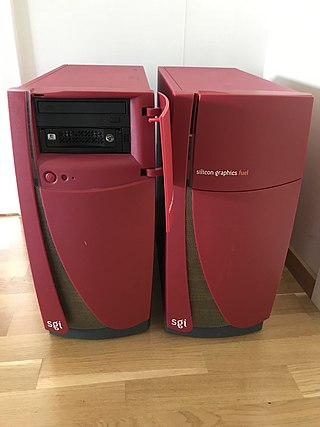Related Research Articles

The GeForce 256 is the original release in Nvidia's "GeForce" product line. Announced on August 31, 1999 and released on October 11, 1999, the GeForce 256 improves on its predecessor by increasing the number of fixed pixel pipelines, offloading host geometry calculations to a hardware transform and lighting (T&L) engine, and adding hardware motion compensation for MPEG-2 video. It offered a notable leap in 3D PC gaming performance and was the first fully Direct3D 7-compliant 3D accelerator.

The SGI Indigo2 and the SGI Challenge M are Unix workstations which were designed and sold by SGI from 1992 to 1997.

The Octane series of IRIX workstations was developed and sold by SGI in the 1990s and 2000s. Octane and Octane2 are two-way multiprocessing-capable workstations, originally based on the MIPS Technologies R10000 microprocessor. Newer Octanes are based on the R12000 and R14000. The Octane2 has three improvements: a revised power supply, system board, and Xbow ASIC. The Octane2 has VPro graphics and supports all the VPro cards. Later revisions of the Octane include some of the improvements introduced in the Octane2. The codenames for the Octane and Octane2 are "Racer" and "Speedracer" respectively.

The SGI Fuel is a mid-range workstation developed and manufactured by Silicon Graphics, Inc. (SGI). It was introduced in January 2002, with a list price of US$11,495. Together with the entire MIPS platform, general availability for the Fuel ended on December 29, 2006. An equivalent product for the same market segment was not provided until 2008, when the Virtu product line was introduced, based on x86 microprocessors and Nvidia graphics.

The SGI Tezro is a series of high-end computer workstations sold by SGI from 2003 until 2006. Using MIPS CPUs and running IRIX, it is the immediate successor to the SGI Octane line. The systems were produced in both rack-mount and tower versions, and the series was released in June 2003 with a list price of US$20,500. The Tezro was released alongside the SGI Onyx 4 and rack-mountable Tezros share many components with it, including plastic skins. The rack-mounted Tezros are functionally very similar to an Infinite Performance-equipped SGI Onyx350. Tezro marked the return of the original cube logo to SGI machines.
XIO is a packet-based, high-performance computer bus employed by the SGI Origin 2000, Octane, Altix, Fuel and Tezro machines. The XIO forms a bus between high-performance system devices and the memory controller.

The O2 is an entry-level Unix workstation introduced in 1996 by Silicon Graphics, Inc. (SGI) to replace their earlier Indy series. Like the Indy, the O2 uses a single MIPS microprocessor and was intended to be used mainly for multimedia. Its larger counterpart is the SGI Octane. The O2 was SGI's last attempt at a low-end workstation.

The Voodoo 5 was the last and most powerful graphics card line that was released by 3dfx Interactive. All members of the family were based upon the VSA-100 graphics processor. Only the single-chip Voodoo 4 4500 and dual-chip Voodoo 5 5500 made it to market.

SGI Visual Workstation is a series of workstation computers that are designed and manufactured by SGI. Unlike its other product lines, which used the 64-bit MIPS RISC architecture, the line used Intel Pentium II and III processors and shipped with Windows NT 4.0 or Windows 2000 as its operating system instead of IRIX. However, the Visual Workstation 320 and 540 models deviated from the architecture of IBM-compatible PCs by using SGI's ARCS firmware instead of a traditional BIOS, internal components adapted from its MIPS-based products, and other proprietary components that made them incompatible with internal hardware designed for standard PCs and hence unable to run other versions of Microsoft Windows, especially Windows 9x. By contrast, the remaining models in the line are standard PCs, using VIA Technologies chipsets, Nvidia video cards, and standard components.
The Indigo, introduced as the IRIS Indigo, is a line of workstation computers developed and manufactured by Silicon Graphics, Inc. (SGI). SGI first announced the system in July 1991.

Number Nine Visual Technology Corporation was a manufacturer of video graphics chips and cards from 1982 to 1999. Number Nine developed the first 128-bit graphics processor, as well as the first 256-color (8-bit) and 16.8 million color (24-bit) cards.

Savage was a product-line of PC graphics chipsets designed by S3.

Quadro was Nvidia's brand for graphics cards intended for use in workstations running professional computer-aided design (CAD), computer-generated imagery (CGI), digital content creation (DCC) applications, scientific calculations and machine learning from 2000 to 2020.

The Radeon R100 is the first generation of Radeon graphics chips from ATI Technologies. The line features 3D acceleration based upon Direct3D 7.0 and OpenGL 1.3, and all but the entry-level versions offloading host geometry calculations to a hardware transform and lighting (T&L) engine, a major improvement in features and performance compared to the preceding Rage design. The processors also include 2D GUI acceleration, video acceleration, and multiple display outputs. "R100" refers to the development codename of the initially released GPU of the generation. It is the basis for a variety of other succeeding products.

The ATI Rage is a series of graphics chipsets developed by ATI Technologies offering graphical user interface (GUI) 2D acceleration, video acceleration, and 3D acceleration developed by ATI Technologies. It is the successor to the ATI Mach series of 2D accelerators.
The SGI Origin 2000 is a family of mid-range and high-end server computers developed and manufactured by Silicon Graphics (SGI). They were introduced in 1996 to succeed the SGI Challenge and POWER Challenge. At the time of introduction, these ran the IRIX operating system, originally version 6.4 and later, 6.5. A variant of the Origin 2000 with graphics capability is known as the Onyx2. An entry-level variant based on the same architecture but with a different hardware implementation is known as the Origin 200. The Origin 2000 was succeeded by the Origin 3000 in July 2000, and was discontinued on June 30, 2002.
The Origin 3000 and the Onyx 3000 is a family of mid-range and high-end computers developed and manufactured by SGI. The Origin 3000 is a server, and the Onyx 3000 is a visualization system. Both systems were introduced in July 2000 to succeed the Origin 2000 and the Onyx2 respectively. These systems ran the IRIX 6.5 Advanced Server Environment operating system. Entry-level variants of these systems based on the same architecture but with a different hardware implementation are known as the Origin 300 and Onyx 300. The Origin 3000 was succeeded by the Altix 3000 in 2004 and the last model was discontinued on 29 December 2006, while the Onyx 3000 was succeeded by the Onyx4 and the Itanium-based Prism in 2004 and the last model was discontinued on 25 March 2005.

InfiniteReality refers to a 3D graphics hardware architecture and a family of graphics systems that implemented the aforementioned hardware architecture that was developed and manufactured by Silicon Graphics from 1996 to 2005. The InfiniteReality was positioned as Silicon Graphics' high-end visualization hardware for their MIPS/IRIX platform and was used exclusively in their Onyx family of visualization systems, which are sometimes referred to as "graphics supercomputers" or "visualization supercomputers". The InfiniteReality was marketed to and used by large organizations such as companies and universities that are involved in computer simulation, digital content creation, engineering and research.

The Xbox technical specifications describe the various components of the Xbox video game console.
IMPACT is a computer graphics architecture for Silicon Graphics computer workstations. IMPACT Graphics was developed in 1995 and was available as a high-end graphics option on workstations released during the mid-1990s. IMPACT graphics gives the workstation real-time 2D and 3D graphics rendering capability similar to that of even high-end PCs made well after IMPACT's introduction. IMPACT graphics systems consist of either one or two Geometry Engines and one or two Raster Engines in various configurations.
References
- ↑ "EXT_fragment_lighting". Archived from the original (TXT) on 2016-03-19.
- ↑ "SGI Tezro vs a modern dual Xeon system. Does it still win on anything? - Ars Technica OpenForum". 28 December 2012.
- ↑ "Octane2 Vpro based on GeForce2?".